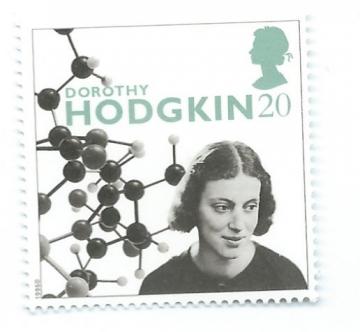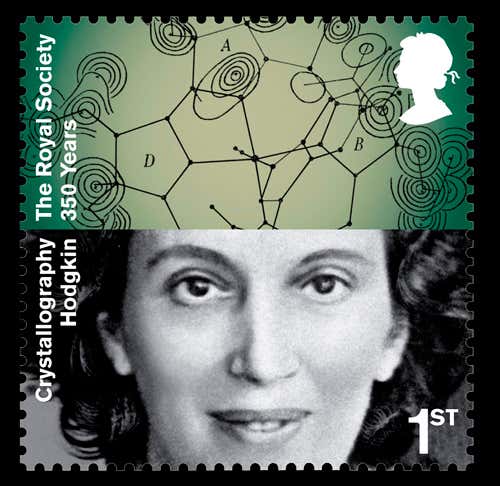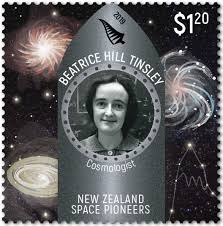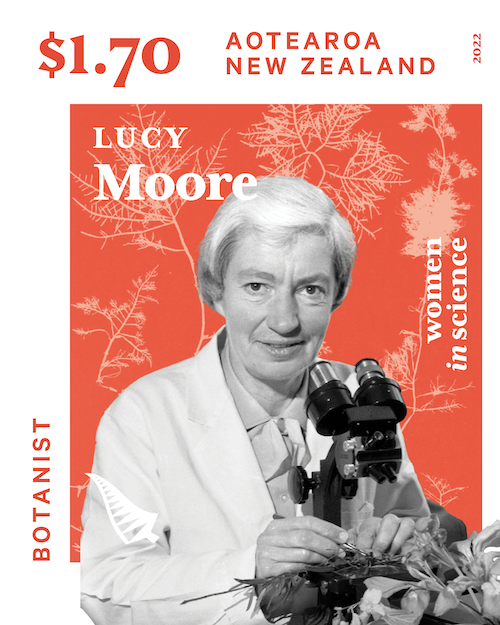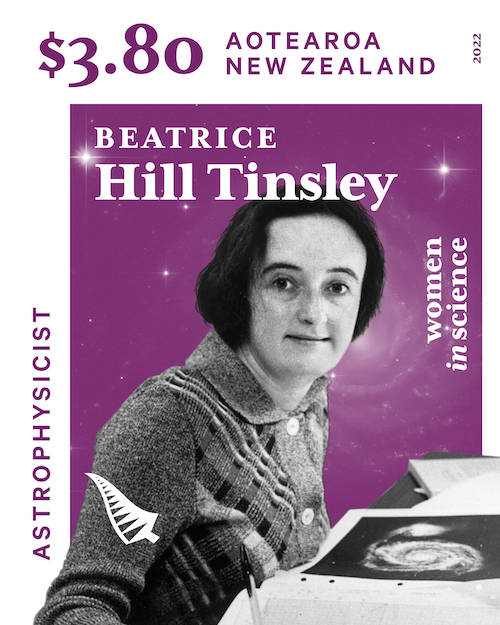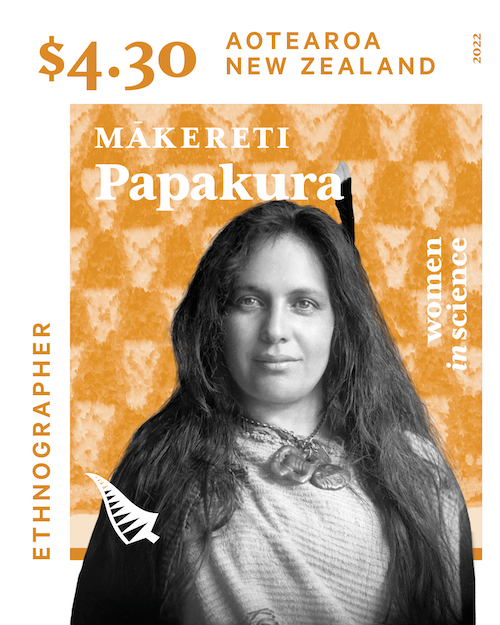PhD part 16: Stamping it out: are portrayals of scientists getting less sexist?
I’ve been revisiting a lot of readings this last week. Dredging my research out of the lockdown lay-by and trying to reestablish my flow, I found a little red bullet point in my thesis draft that simply said: ‘contextualise what science is here’.
I’ve been revisiting a lot of readings recently. Dredging my research out of the lockdown lay-by and trying to reestablish my flow, I found a little red bullet point in my thesis draft that simply said: ‘contextualise what science is here’. Like putting a jaunty little rug over a trapdoor over an enormous rabbit hole, I blundered into my own booby trap. I don’t know if I was being naive or optimistic or in denial, making it sound like I could churn out a couple of hundred words and put to bed ‘what is science?’ once and for all. But, I’ve been enjoying getting lost in it again.
While mulling over my own preconceptions about what science looks like and how it manifests visually, I came across an anecdote from Michael Reiss (2004, p.4) in a book chapter on science teaching. He highlights a set of stamps produced in the UK in 1991 on the theme of ‘Scientific achievements’. The stamps were captioned ‘Faraday—Electricity’, ‘Babbage—Computer’, ‘Radar—Watson-Watt’ and ‘Jet Engine—Whittle’. Reiss says:
I find it difficult to imagine a narrower conception of what science is and who does it. The image seems to be that real science is hard physics, with military applications, done by males who are white and worked on their own between about 1820 and 1940.’
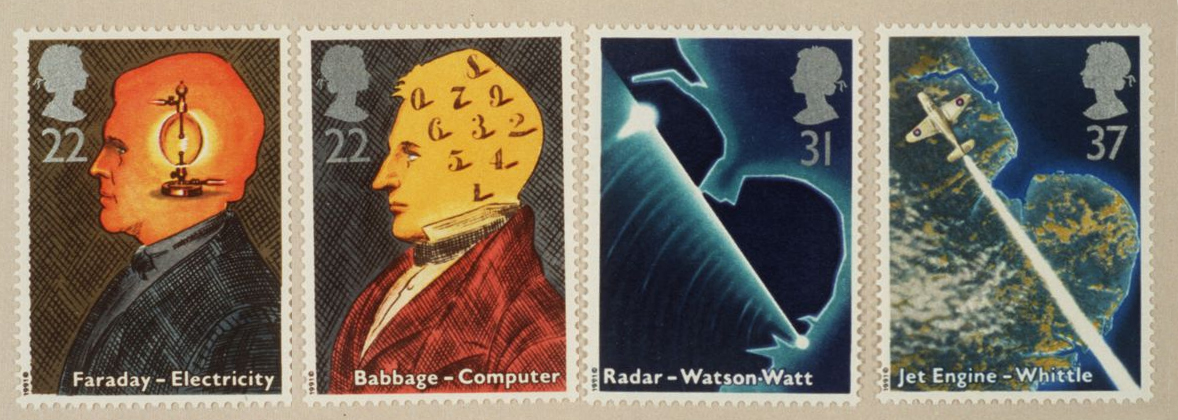
Postage stamps (4), scientific achievements, Royal Mail, United Kingdom, 1991. Retrieved from https://collection.maas.museum/object/149421.
‘Both miniature art works and pieces of government propaganda’
This piqued my interest, because I am a designer, and as a designer I perhaps look at stamps more than most. I have always thought them little abstracted encapsulations of what we value as a culture: ‘both miniature art works and pieces of government propaganda’ (Altman, 1991, p.2). So I wondered, how much has changed in the three decades since this science portrait-in-miniature set was released? If stamps are a mini-mirror of what we value and how we see things, has how we see ‘the scientist’ changed significantly since Reiss made his observation? I sifted through the back catalogue of commemorative stamp sets in the UK to find out…
Flip forward to 1996 and a woman scientist does get some philatelic credit. Chemist (and the only British woman to have received the Nobel Prize for science, for her work on crystallography that revealed the three-dimensional structures of biochemical compounds, notably vitamin B12 and penicillin) Dorothy Hodgkin joined a ‘20th Century Women of Achievement’ stamp set:

Postage stamps (5), 20th century women of achievement, Royal Mail, United Kingdom, 1996. Retrieved from https://www.bfdc.co.uk/1996/issues/women_of_achievement/stamps.html.
It seems churlish to look askance at anything that recognises and champions the achievements of women, but it does seem to tacitly acknowledge that all other stamp sets lauding other achievements are the domain of men… Anyway, onward!
For the millennium there was a series of mini-collections released as ‘Tales’. These included a Scientists’ Tale, as well as a ‘science adjacent’ set of stamps; ‘The Inventors’ Tale’ (others included the Entertainers’, Farmers’, Travellers’, Citizens’, Soldiers’, Artists’, Workers’ and Patients’ Tales).
The Scientists’ Tale had the words Decoding DNA, Newton/Hubble Telescope, Faraday’s electricity and Darwin’s theory, and were illustrated without portraits or further reference to the scientists:

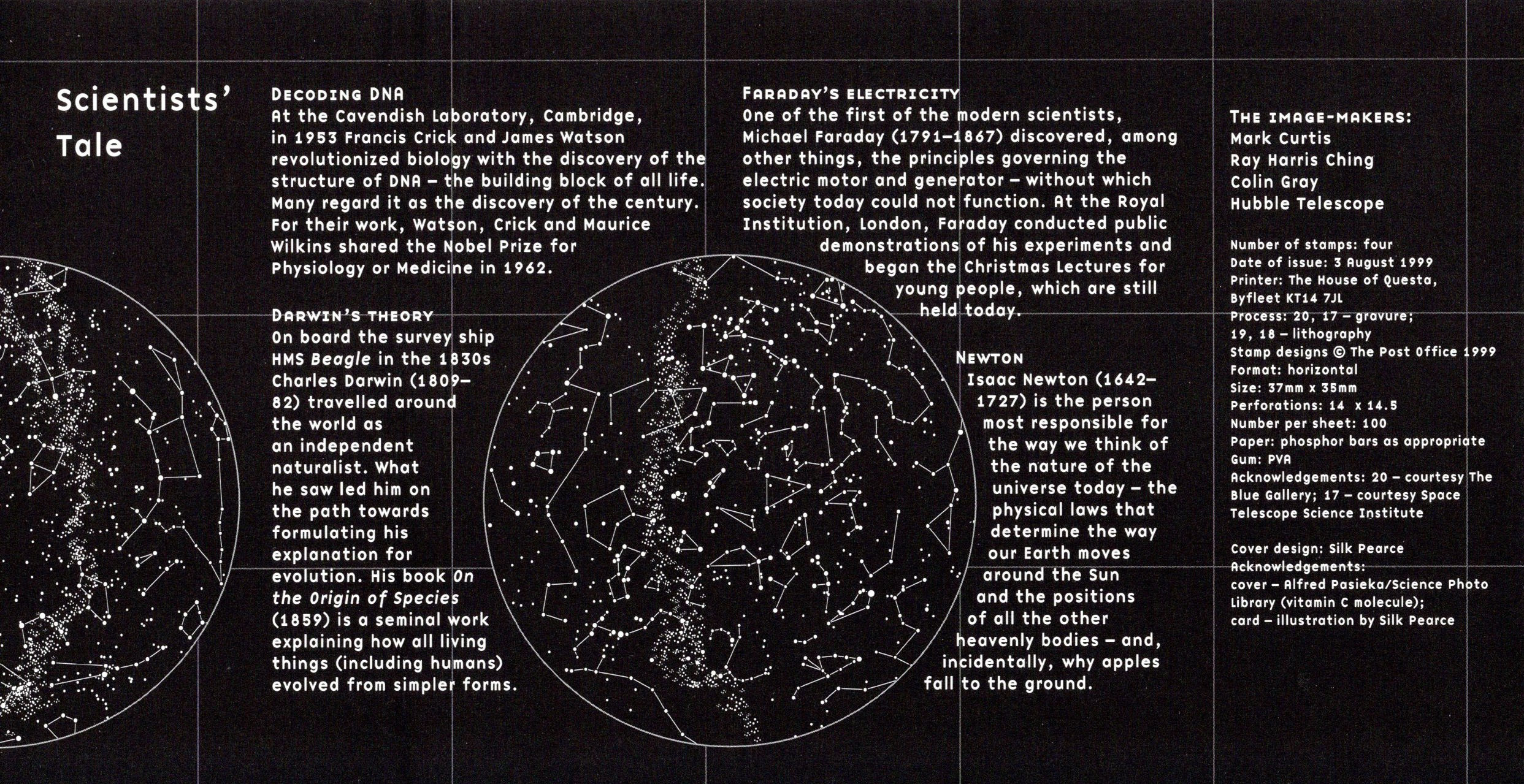
Postage stamps (4), The Scientists’ Tale, Royal Mail, United Kingdom, with first day cover insert sheet, 1999. Retrieved from http://www.paleophilatelie.eu/description/stamps/uk_1999.html see also https://www.collectgbstamps.co.uk/explore/issues/?issue=242.
However, the presentation pack gives further detail, name-checking James Watson, Francis Crick and Maurice Wilkins for the DNA discovery (no credit given to Rosalind Franklin), with Darwin, Newton and Faraday’s accomplishments also expanded upon.
The Inventors’ Tale highlighted Timekeeping (with the back detailing John Harrison and his chronometer), Steam power (James Watt), Photography (Henry Fox-Talbot's photographic experiments) and Computers (Alan Turing). Though all these scientific discoveries and inventions are largely associated with and credited to men, perhaps the fact that the stamps themselves highlight the invention over the inventor is by extension a nascent shift to focusing on the societal impact over the lauding of the individual. Or is that seeing what I want to see?
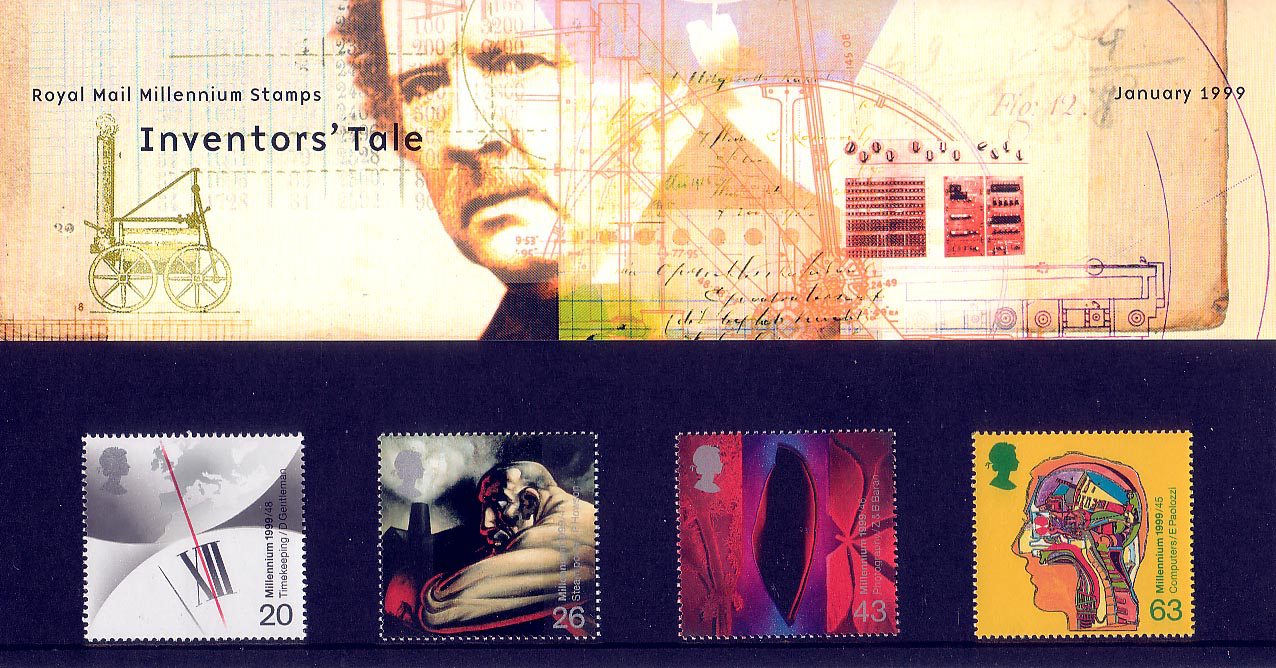
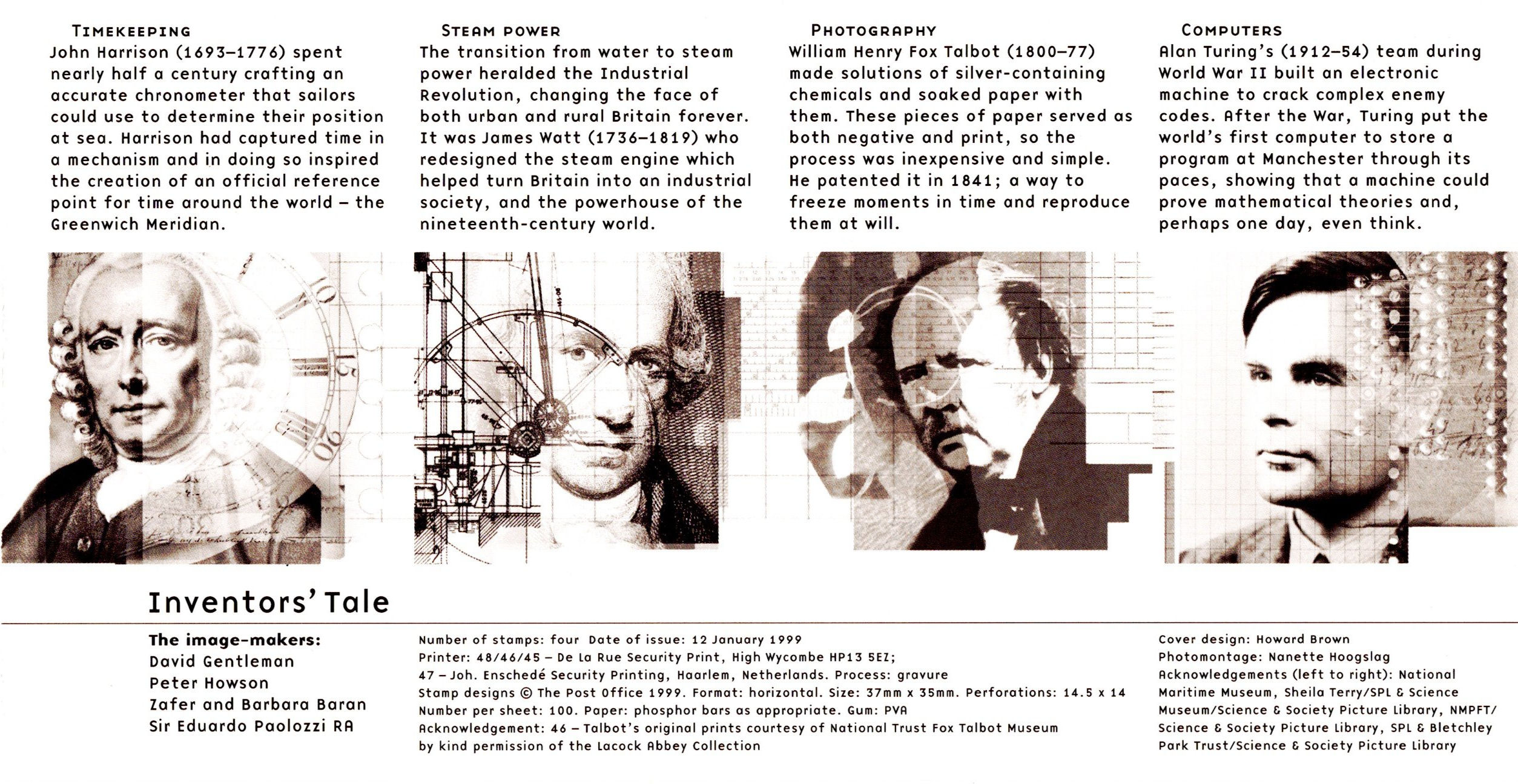
Postage stamps (4), Millennium stamps: Inventors’ Tale, Royal Mail, United Kingdom, 1999, and associated first day cover insert. Retrieved from https://www.collectgbstamps.co.uk/explore/issues/?issue=234.
2003 saw another stamp set focusing on achievements rather than the scientists specifically, this time featuring cartoons for a ‘The secret of life: DNA and the genome’ set. This collection tried (not altogether successfully, according to the Royal Mail’s head of stamp strategy) to use humour to engage the public with science (Yardley, 2015, p.188). Though there are no names given on the stamps, the cartoons do feature two white-coated men assumed to be Watson and Crick, and the cover text names them specifically (definitely a missed opportunity to acknowledge Rosalind Franklin):
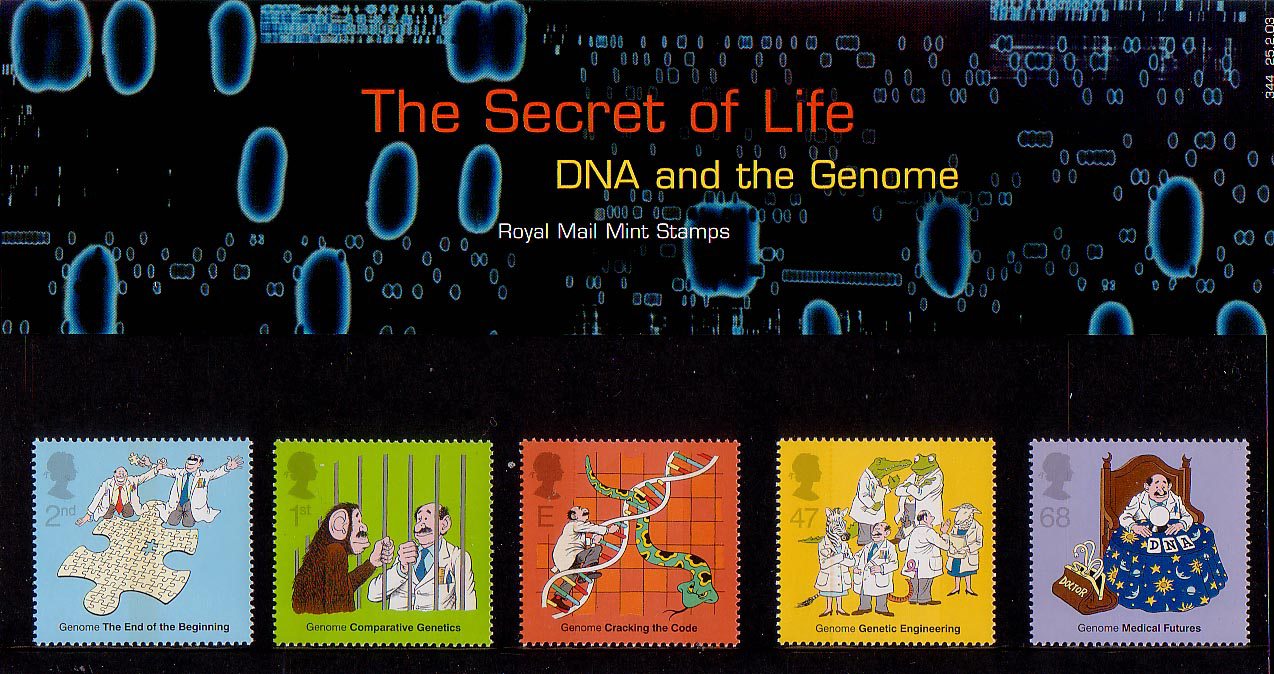
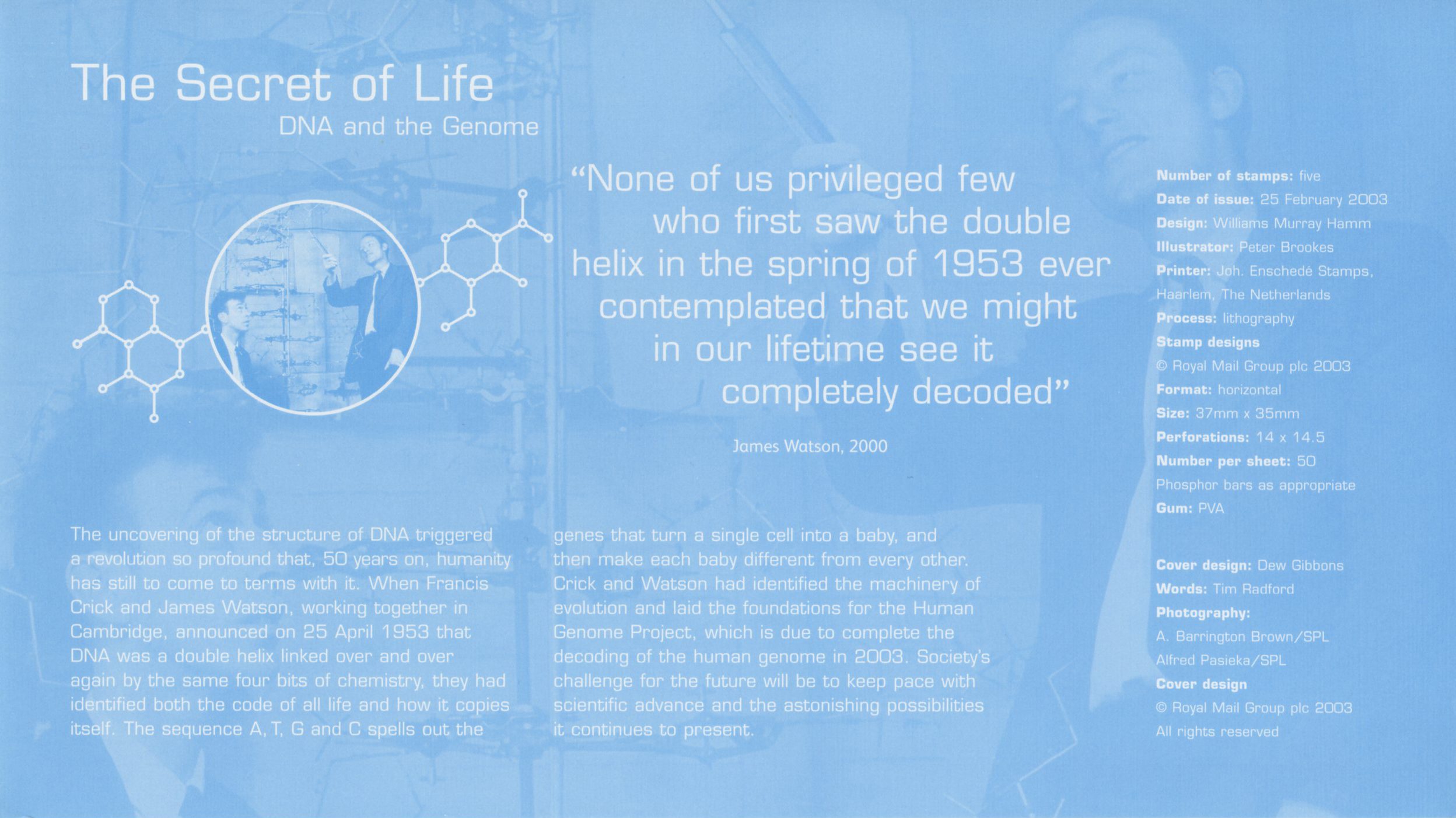
Postage stamps (5), The secret of life: DNA and the genome and associated first day cover insert, Royal Mail, United Kingdom, 2003. Retrieved from https://www.collectgbstamps.co.uk/explore/issues/?issue=354#collectgbstamps-6.
Almost two decades on from the 1991 collection, 2010 saw 350 years of the UK Royal Society celebrated with a fresh set of lickable scientists, this time featuring a woman: Dorothy Hodgkin. Again. Laudable and absolutely worthy of the recognition of course, but still just the one.
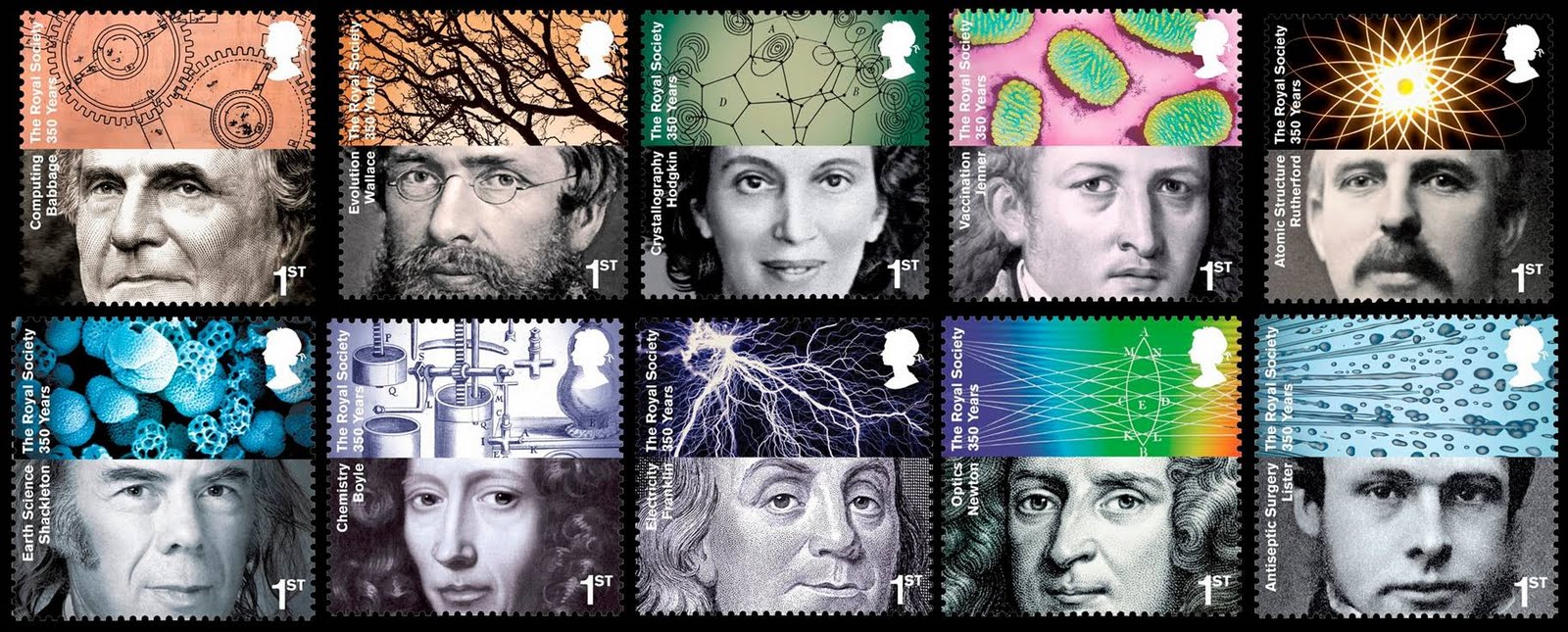
Postage stamps (10), 350 Years of the Royal Society, Royal Mail, United Kingdom, 2010. Retrieved from https://www.commarts.com/project/17223/the-royal-society-350-years-stamp-presentation-pack. See also https://www.newscientist.com/gallery/the-royal-society-stamp/.
Though at least this is above average with a 1:10 gender ratio. Christopher Yardley (2015) points to a 24:1 ratio of male to female scientists on stamps recognising ‘science heroes’.
2010 also saw a ‘medical breakthroughs’ set, which didn’t feature portraits, but did name-check six Sirs: Sir James Black (beta-blockers), Sir Alexander Fleming (penicillin), Sir John Charnley (hip replacement), Sir Harold Ridley (artificial lens implant), Sir Ronald Ross (confirmation malaria transmitted by mosquitoes) and Sir Godfrey Hounsfield (CT scanner). 2012’s ‘space science’ set focussed solely on discoveries rather than people, featuring imagery from observatories, satellites and probes.
And that’s it for scientists on UK stamp sets, though Mary Leakey the British paleoanthropologist did make the 2013 ‘Great Britons’ set of ten (alongside actress Vivian Lee and cookery writer Elizabeth David; the remaining seven were men).
How about here?
But Is this a British issue? Alas no. Yardley also flags a serious blot on the copy book for Aotearoa: ‘no recognised female scientist has appeared on a New Zealand postage stamp’ (Yardley, 2015, p.184).
Subsequently however, there has been a glimmer of hope with the 2019 inclusion of Beatrice Hill Tinsley and Pamela Kilmartin (alongside husband and fellow astronomer Alan Gilmore) in the set of ‘New Zealand Space Pioneers’ stamps:

Postage stamps (5), New Zealand Space Pioneers, New Zealand Post, Aotearoa New Zealand, 2019. Retrieved from https://sciblogs.co.nz/news/2019/05/03/new-zealands-space-pioneers-stamp-their-mark/.
A little picture of us?
Does the depiction of scientists on stamps matter that much? Do stamps reflect what we value, or lead what we value? Perhaps a bit of both. Certainly, historically, stamps could have ‘considerable nation‐building power [making them] exemplary tools of what social scientist Michael Billig calls ‘banal nationalism’ (Raento & Brunn, 2005, p. 145). This makes them valuable territorially specific texts for political and sociocultural analysis, offering ‘valuable insights into the evolution and outlook of the issuing state’. My brief analysis of science stamps suggests that we're not evolving towards proactively recognising, acknowledging, and encouraging diversity in science very fast.
As an aside, If stamps are ‘valuable insights’ showing us microcosms of culture, the 2020 Royal Mail special releases list makes intriguing reading: video games; James Bond; Sherlock Holmes; Visions of the Universe; Rupert the Bear; the end of the Second World War; views of Westminster; Queen (the band—the other one gets plenty of coverage!); romantic poets; Coronation Street; Star Trek… In Aotearoa, 2020 stamps included the Year of the Ox; the Tokyo Olympic Games; Peter McIntyre's World War II (he was New Zealand’s ‘official war artist’), plus another set for WWII 75 year anniversary; The Four Winds, stories to celebrate Matariki; Māori Language Week Te Wiki o te Reo Māori; Kiwi cakes; parakeets; moths, and the ‘New Zealand Bear Hunt’ (celebrating the bears people put in their windows during the first lockdown). Unpack that, anthropologists!
Michael Reiss (2004, p.3) said of the 1991 scientific achievements set:
It seems sad that the Royal Mail could produce a set of stamps that portrayed such a biased view of science. Stamps to feature scientists could convey the notion that women do science, that science didn’t start in the nineteenth century and finish around the time of the Second World War, that it isn’t a Western construct, that it is done by people working in groups and that it permeates every area of life.
Sadly, it seems those same criticisms largely remain true of efforts since. Hmm, I feel a design project coming on to do better!
References
Altman, D. (1991). Paper Ambassadors: The Politics of Stamps. Angus & Robertson.
Raento, P., & Brunn, S. D. (2005). Visualizing Finland: Postage Stamps as Political Messengers. Geografiska Annaler: Series B, Human Geography, 87(2), 145–164. https://doi.org/10.1111/j.0435-3684.2005.00188.x
Reiss, M. (2004). What is science? Teaching science in secondary schools. In E. Scanlon, Reconsidering Science Learning (pp. 3–12). RoutledgeFalmer.
Yardley, C. B. (2015). The Representation of Science and Scientists on Postage Stamps: A science communication study. ANU Press; JSTOR. https://www.jstor.org/stable/j.ctt15hvqxp.9
Postscript: Designing a more diverse view of science?
In October 2020 on Twitter, the @CitSciMonth account (an account from which a guest citizen science community member tweets for a set period of time) featured some Australian citizen science stamps. The guest tweeter had submitted the idea to Australia Post, and it had eventually been accepted. In a Twitter conversation they suggested I do the same, sending me the NZ Post web form that said ‘Kiwis can Suggest A Stamp Series’. So, I filled in the form, stating:
…I was thinking that Aotearoa should have a 'science and society' stamp series that could cover science communication and citizen/participatory science here in NZ. Recently I was researching the representation of women scientists on stamps and up until 2019's NZ Space Pioneers series we hadn't had any women scientists represented on stamps at all. This would be a perfect opportunity to celebrate diverse groups and people and the way science and society intersect here…
A day later, I got a pleasant response from Lynette Townsend, Programme and Content Manager for NZ Post Collectables. She said that both ideas—and especially ‘women in science’—were interesting and though the programme was full for 2021, they would be kept on file. With the contact details of a real person, I responded immediately to try to get a face-to-face meeting. I highlighted that within Te Pūnaha Matatini there were several people with specific expertise around women scientists’ representation, and many actual scientists who were also women. Two months later in December—after I had long written off the correspondence as a ‘thanks but no thanks’—I got an apologetic response offering to meet in the new year.
I quickly went to work compiling some potential scientists to feature. Unbeknownst to me, Rebecca Priestley had co-authored a book titled ‘Atoms, Dinosaurs & DNA: 68 Great New Zealand Scientists’ (Meduna & Priestley, 2008) which contained 12 women amongst the 68 profiles. Royal Society Te Apārangi had produced a ‘150 women in 150 words’ series celebrating ‘women’s contributions to expanding knowledge in New Zealand, running as part of [their] 150th Anniversary (royalsociety.org.nz/150th-anniversary/150-women-in-150-words/). I also drew on Kate Hannah’s work on ‘deconstructing women’s invisibility’ in the scientific establishment (Hannah, 2017).
Townsend and I met in January 2021. I got a crash course in producing stamp collections to appeal to the collector market (the primary reason ‘special issue’ stamps exist). Most notably, the featured people needed to be deceased! Despite some initial reluctance (it being a somewhat non-standard pitch; usually they are designed in-house) Townsend was receptive to my designing the stamps, and also to including Rebecca and Kate Hannah in the research and writing.
Several Zoom meetings saw the shortlist formed. There were a few paralysing moments where I felt hamstrung: how was it four white women, only one of whom had been a scientist, were making this decision about which women could represent science in Aotearoa? How could we ensure diversity—in terms of ethnicity, and disciplinarity—was represented? When we did make a selection, how could we make sure the families—iwi and hapu—were on board rather than assuming the women were ‘public property’? We agreed early that at least one of the women should be an Indigenous scholar, but would we run into issues with ‘Māori science’ not being accepted as science? Was having ‘women in science’ stamps (rather than scientist stamps that just happened to feature four women) even helpful, or did it just ghettoise women in science further?
Kate Hannah’s position as a feminist historian—knowing the lenses through which she approached her research, with its commitment to ‘countering invisibility’ by ‘reading against the grain of supposedly self-evident truths, rather than taking them for granted’ (Eagleton, 2004 quoted in Hannah, 2017, p. 149) was critical in allaying my discomfort. Within the ‘safe space’ of supportive colleagues with whom it was acceptable to voice thoughts without judgement, aided by the need for pragmatic design decisions to be made, the stamps took shape. The pragmatic decisions became particularly stark when choosing our Indigenous scientist. The ‘must be dead’ requirement meant contemporary Māori women scientists were off the list, but the need for visual continuity meant the timeframe of available contenders was narrower than we might have liked: after the first few iterations, I had settled on using photographic portraits of the women rather than an abstract representation of their work. The original shortlist included Whakaotirangi (Pre-1400 experimental gardener) and Kahupeka (Pre-1500 discoverer of medicines) (Royal Society Te Apārangi, 2017) alongside our eventual selection Mākereti Papakura, but photographic portraits were clearly not available for the first two. Further on in the process as we were refining the choice of images, some of the portraits of Papakura—despite being higher resolution—were rejected as discussion underlined that they were portraying her in the fetishised ‘dusky maiden’ stereotype, for a colonial Victorian gaze.
Design decisions
As I was going through routine design decisions, I found myself hyper-vigilant about falling into unthinking default positions, balancing the aesthetic eye honed through design training with undertaking the design process in a consciously reflexive way. Of course it’s part of a designer’s role to calibrate the semiotic associations of symbols within a design, but that usually happens almost unconsciously, with the occasional unintended association picked up in critique with peers or testing. The only time I’d previously made overt documentation of my ethical decisionmaking was during my Master’s research, but even then it was somewhat retrospective. The discussion with Townsend, Priestley and Hannah acted as a place to verbalise and air the design decisions that I’d made as I was working through them; the iterative nature of design, thinking and talking became braided together.
Some of these discussions included: Is it cliche to use purple (the colour most associated with women’s suffrage)? No, I decided. Purple became the base from which to build the colour system. Is it wrong to default to using red for Makereti Papakura because it’s closely related with Māori visual language? A bit lazy, I thought, and the ochre colour comes from her cloak image so is more pertinent. Is it dismissive to treat images from scientific papers or research notes as visual decoration? Perhaps, but it is also paying homage to the actual material generated through the act of being a scientist. Am I saying something with the denomination of stamps attributed to each scientist? No, the denominations go chronologically, and I am choosing the order based on the way the colours look together. I made the decisions about who got which colour for valid reasons: Wiffen got green because the site of her digs were dense with stunning emerald bush; Hill Tinsley got purple as it was closest to the astral sky; Moore got red for the Pterocladia lucida seaweed she studied. Late in the process, we had protracted discussions about ‘post-marriage erasure’ regarding whether to address Beatrice Hill Tinsley as such, or use just her married name, Tinsley (which was the one she used, despite having divorced). We took advice and collectively made the call to use the longer ‘Hill Tinsley’ for consistency with the previous stamp on which she had appeared. The right decision, though it vexed me as it meant a point-size adjustment to the typographic system!
I found myself reassured by the consultation process Hannah undertook with Te Pūnaha Matatini’s kaumātua Dr Tom Roa (Ngāti Maniapoto), though guilty and out of my depth that I’d not have known where to go to have conversations with mana whenua myself. The discomfort of white guilt—a recognition of white privilege—is often easy to ignore as a designer. As I tried to do better (introducing bilingual titles, for instance) it felt like lip service. I sat with that discomfort. When we requested use of the image of Papakura’s cloak from Te Papa Tongarewa (Kahu Huruhuru (Feather Cloak), 1850–1880), the licencing manager escalated the enquiry to a team who could decide if iwi permission needed to be sought. It hadn’t crossed my mind that we would need that permission, and I was instantly embarrassed that I hadn’t considered it.
The collection of stamps was released in 2022, and they are probably my proudest design moment. This was magnified when a design industry contact got in touch to say that Lucy Moore was his great aunt, and how moved, proud and delighted he was that she was honoured in this way. Though Rhian and Rebecca pressed me on occasion about how relevant this side project was to my thesis, I am convinced of its validity as an outcome generated by the particular ‘petri-dish’ of design, reflexive practice and science communication. The project would not have arisen if it wasn’t for my own research, thinking about the meaning and nature of science through the lens of how it appears in the landscape of visual communication, and what that means for the science/society relationship. The stamps simply would not have occurred if it wasn’t for the road the PhD research set me on. That it spawned a collaboration to make women in science more visible, undertaken by a cross-disciplinary group of women researchers affiliated with Te Pūnaha Matatini is also a testament to TPM’s research culture and ethos of collaboration.
But are the stamps science communication? Broadly, yes, in the way Burns et al. (2003, p. 191) classify scicomm, they required ‘appropriate skills, media’ to produce ‘enjoyment or other affective responses’ that relate to ‘understanding of science, its content, processes, and social factors’. In the sense Horst et al. (2017, p. 883) frame the term, it is ‘organised and explicit’ communication and ‘non-scientists’ are part of the target audience. So this is what the petri-dish grew: a reflexively enabled, co-produced piece of science communication graphic design that perhaps nudges the way science is understood and constructed by society in some small way.
